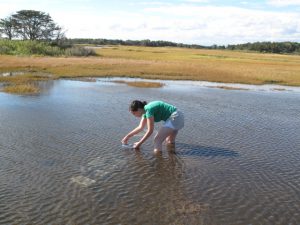Stella goes wild!
We are happy to announce the recent online publication of: Tarrant AM, RR Helm, O Levy, HR Rivera. Environmental entrainment demonstrates natural circadian rhythmicity in the cnidarian Nematostella vectensis. In the Journal of Experimental Biology. jeb.205393 doi: 10.1242/jeb.205393 Published 14 October 2019. The photo shows Rebecca Helm deploying anemones in their native environment. The work was funded by the Gordon and Betty Moore Foundation.
Fruit flies, lab rats, baker’s yeast. Model organisms are cool…they are usually easy to breed, cultivate and manipulate in lab experiments. The starlet sea anemone Nematostella vectensis (affectionately nicknamed ‘Stella’) is a cnidarian model species. You know those low maintenance houseplants that you can stick in a dingy room and forget to water and somehow they still live? ‘Stella’ is the sea anemone equivalent of the really hardy houseplant. You can grow them in Tupperware dishes of diluted seawater, occasionally throw in some brine shrimp and change the water every now and then. Of course, some more advanced animal husbandry (i.e., TLC) goes a long way, especially if you want to perform genetic manipulations, perform repeatable experimental, or otherwise get fancy. Anyway, because it is easy to manipulate in the lab, ‘Stella’ has been the subject of many scientific studies over the years. My lab has used ‘Stella’ to study the evolution of nuclear hormone receptors, responses to oil pollution, sensitivity to UV radiation, and most recently, circadian rhythms.
 Circadian rhythms, roughly daily rhythms in behavior and physiology, allow organisms to anticipate and prepare for daily changes in their environment. Over the years, we’ve learned that even the sea anemone exhibits a circadian rhythm. They tend to move more at night, their metabolic rate rises during the day, and many of their genes show daily cycles in expression. But that’s all in the lab? What do they do in the real world? Would the respond to the day/night cycle, or would tides have a bigger influence? How would we measure that? And why do they even need circadian rhythms? We figured out a way to approach this by putting our lab animals back out into the field in small mesh cages. The cages were necessary because the animals can be small and hard to find (none of us wanted the job of trying to find nearly invisible anemones in the middle of a salt marsh at night). After a few weeks, we retrieved the cages, and studied the behavior and gene expression of the anemones. We learned a bunch of things, but here are the three things that I think are most interesting:
Circadian rhythms, roughly daily rhythms in behavior and physiology, allow organisms to anticipate and prepare for daily changes in their environment. Over the years, we’ve learned that even the sea anemone exhibits a circadian rhythm. They tend to move more at night, their metabolic rate rises during the day, and many of their genes show daily cycles in expression. But that’s all in the lab? What do they do in the real world? Would the respond to the day/night cycle, or would tides have a bigger influence? How would we measure that? And why do they even need circadian rhythms? We figured out a way to approach this by putting our lab animals back out into the field in small mesh cages. The cages were necessary because the animals can be small and hard to find (none of us wanted the job of trying to find nearly invisible anemones in the middle of a salt marsh at night). After a few weeks, we retrieved the cages, and studied the behavior and gene expression of the anemones. We learned a bunch of things, but here are the three things that I think are most interesting:
- Pulling the anemones out of the marsh and bringing them back into the lab messes them up! We saw that for the first day back in the lab, they seemed “freaked out” and didn’t move much. It makes sense…a petri dish is very different than the real world. They were initially confused, but don’t worry, they recovered.
- The sun wins over the moon. I’m kind of joking with this, but what I mean is that we saw strong daily (sun) cycles and much less evidence of tidal cycles (mostly driven by the moon). Some of this might be specific to our study site, which only really ‘sees’ the tides a few times of the month (around full moon and new moon). It would be cool to learn more about behavioral rhythms in anemones from other sites that experience more regular tides.
- The sun is a big deal. In previous lab experiments, we showed that ‘Stella’ is sensitive to UV radiation. At the time, I was a little unsure how useful those experiments were. These anemones burrow into the salt marsh sediments, so I figured that if the light was bothering them, it would be pretty easy to avoid it. We saw that the animals we collected from the cages exhibit daily cycles in UV-protective genes. The most logical explanation for this is that they express those genes because they need to…the sun does affect them and they need to protect themselves from what would otherwise be damaging radiation.
So what’s next for ‘Stella’ in our lab? We still have lots of data to write up! Hanny Rivera has some really interesting data on parental effects on thermal tolerance. Cory Berger has started a new set of experiments looking at thermal entrainment of circadian clocks. We’re hoping that Hanny’s paper will be coming out early in 2020, and Cory will be presenting his initial results at the annual SICB meeting in January 2020. Stay tuned!